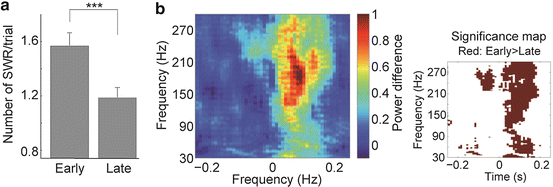Fig. 1
(a) Examples of SWR; the upper signal was filtered between 150 and 250 Hz, the lower signal was non-filtered (1–475 Hz). A vertical dashed line indicates SWR detection point. (b) SWR-triggered power spectrogram. The right figures show the mean power of high gamma to SWR range (upper) and low gamma range (lower) over 100 ms after SWR detection. (c, d) Mean power of low gamma (c) and high gamma (d) in each 100-ms bin. (e) Correlation coefficient between SWR and low gamma

Fig. 2
(a) Number of SWR events per trial in earlier trial and later trials. (*** indicates p < 0.001 on Mann-Whitney U test). (b) The left figure shows the power difference between earlier and later trials. A red color indicates that the power is higher in earlier trials than in later trials. The right figure shows statistically significant results (p < 0.05) between earlier and later trials by Mann-Whitney U test. A red color indicates that the power is significantly higher in earlier trials than in later trials
SWR is thought to result from a synchronized burst in hippocampal CA3 region [5]. However, some components of SWR might be caused by direct input from entorhinal cortex (EC) or by intrinsic CA1 circuitry [6]. We observed decreasing trends of power at wide frequency bands during SWR. Interpreting this result, the input strength from EC and CA3 and the number of activated neurons in CA1 might decrease. Consequently, the number of SWR to exceed threshold might reduce as well. Furthermore, our results showed that the correlation between high gamma (which reflects input from EC) and HFO (which might be lower frequency SWR) changed in the earlier trials as compared to the later trials. Taken together, our findings support the notion that SWR serves to facilitate and stabilize the task behavior and that the inputs from CA3 and entorhinal cortex play a critical role in memory consolidation.
Stay updated, free articles. Join our Telegram channel

Full access? Get Clinical Tree







